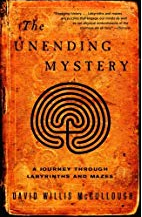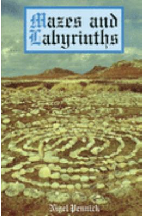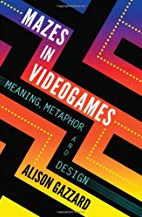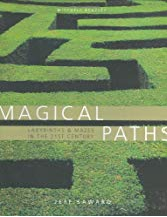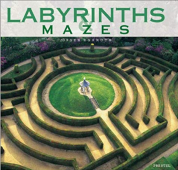Today I am going to explore maze books. But not the typical puzzle maze books that you sit around and solve. No these are books about the making of those mazes, the math of mazes, the history of mazes, the architecture of hedge mazes and labyrinths, and things like that. Books about mazes. Not maze books. If you are looking for reviews of the spiritual aspect of labyrinths, I have written a post about those books separately. This can make for some complicated advanced searches in the library card catalog (it isn’t a card catalog anymore though is it. It’s an online search catalog.) Hopefully these book reviews will give you an idea of which books you might be interested in as I answer 2 big questions for each book: What I learned in this book, and what this book does best. Let’s get started !
Here are the 8 best books about mazes, labyrinths and their history:
The Amazing Book of Mazes by Adrian Fisher 264 pages. AMZN. Adrian Fisher is a great maze designer who pulled together this book showing over 150 maze designs while explaining what makes them unique and important.
What I learned in this book:
Labyrinths and “real world mazes” have been around for about 4,000 years while puzzle mazes have been around for only 500 years.
Vertical mazes: Hedge, Panel, Corn (called Maize mazes in the UK), Mirror and Water are the most common types of vertical mazes.
The first vertical maze in the USA was created in 1805 in Harmony, PA and was made of vines. The oldest surviving maze in the USA is the Vizcaya Maze Garden in Miami , Florida from 1916.
Hedge mazes were first constructed with small hedges. Not until the late 16th Century did gardeners in England begin using the tall hedges that are standard today.
Panel mazes, usually made of wood, first appeared in the year 1900 and allowed the maze to be changed daily for multiple unique trips. The maze craze in Japan from 1984-88 consisted of panel mazes.
The first Corn Maze was developed at Lebanon Valley College in Annville, PA in 1993. From the time the height is correct until the leaves brown a typical corn maze lasts 4-8 weeks. The advantage of Corn mazes is they can be changed yearly, unlike hedge mazes, which must be taken care of consistently for years.
In England the crop of corn is actually what Americans would call wheat, so in England they are called Maize Mazes instead of corn mazes.
The first mirror maze is from Constantinople in 1889. They are a staple of fun houses and tourist areas today.
What I loved about this book: Comprehensive look at real world mazes and their history organized by type.
What this book does best: A great guide to mazes around the world with pictures. A great resource to look deeper into maze design.
Mazes and Labyrinths of The World by Janet Bord 181 pages. AMZN.
What I learned in this book:
The original labyrinth is thought to be on the island of Crete where Theseus defeated the Minotaur at the center of the Cretan Labyrinth.
At one time in the UK it was common for doorsteps to have labyrinth or maze drawings on them to keep evil spirits and witches at bay.
Labyrinths are often linked to death and the passing from the living world to the afterlife
The story of Icarus I knew was he flew too close to the sun melting the wax of his self made wings despite warnings from his father King Minos. The reason he made those wings was to escape a labyrinth he was imprisoned in.
Mazes are common in the following forms by country: England, turf; Sweden, stone; France and Italy, church mosaics.
What this book does best: Discusses the history of Mazes and Labyrinths in Europe, especially England.
The Unending Mystery: A Journey Through Labyrinths and Mazes by David W. McCullough 272 pages. AMZN
What I learned in this book:
The appendix includes step by step examples on how to draw a simple labyrinth and also a classic seven circuit labyrinth
Leonardo da Vinci notebooks from the 1490’s include the entry “repair the labyrinth” on his to do list
Caerdroia magazine, edited by Jeff Saward, is a Journal of Mazes and labyrinths that has been published since 1980. This is supported by the website labyrinthos.com a great place to study all types of mazes and labyrinths online.
The modern use of walking Labyrinths for spiritual practice popularized By Lauren Artress in her 1995 book Walking a Sacred Path (AMZN).
What this book does best: Explores the many reasons people believe labyrinths were used through history, their myths, legends, and rising and waning popularity thru history.
Mazes and Labyrinths by Nigel Pennick 208 pages AMZN
What I learned in this book:
Labyrinths are built from a nine point pattern
In India it is common in some parts of the country to see labyrinths painted or drawn in chalk at doorways to homes. This is thought to keep out evil spirits. This is known as kolam.
In India they also sometimes use a labyrinth as a yantra used for concentration during childbirth. The mother concentrates on solving and unsolving the labyrinth with her eyes as a way to put the mind to work on something other than the pain.
There are 4 types of simple labyrinths: the simple meander, the complex meander, serpentine, and spiral.
The path of the famous Hampton Court maze in England was used as the path for the first maze laboratory experiments with rats. Seems like something that would help you in Jeopardy.
What this book does best: Extremely detailed look at mazes from England, with details on exact measurements and map references. It also is good at speaking about theories of why the labyrinth is found across so many places and cultures.
Mazes in Videogames: Meaning Metaphor and Design by Alison Gazzard 183 pages AMZN
The book explores how the paths of mazes and labyrinths found in the real world have influenced the paths a player experiences while exploring and playing videogames.
What I learned in this book:
There are 6 common path types in video games:
Core Path - You have no choice but to move forward on the main path and no decision to make. i.e. like a labyrinth
Blind Turn - The core path turns and you cannot see what is around the turn/corner. This creates tension for the walker/player and in games is often where enemies will attack from
Forked Path - Where a choice needs to be made to move in one of two possible new directions
Multi Forked Path - Where a choice needs to be made to move in one of more than 2 possible new directions
Loop backs - A path that after taking it returns you to the place where it started.
Loop alongs - A chosen path off the core path that returns to the core path at a point farther on essentially allowing you to skip a portion of the core path.
In Pac-Man, one of the original maze games, the ghosts acts as moving barriers, making completing the maze dynamic
Video games and Maze walkers each need to overcome challenges to solve the puzzle. Each may include dead ends, clues, and both will get better with repetition, i.e multiple plays of a level/ multiple walks of the maze.
Speed runs are a popular way to get into video game record books. Real world mazes sometimes have similar challenges, seeing how fast a person can solve the maze.
What this book does best: Takes a big picture view of how video games present pathways to the player. The different designs encountered and examples of games that best represent the pathways.
Magical Paths: Labyrinths & Mazes in the 21st Century By Jeff Saward 176 pages AMZN
This book is a great overview of the history of mazes and labyrinths. It speaks to the mythology and symbolism of the works from the past through the present day. Great photos and examples. Nice resources in the back with locations of popular mazes and relevant websites.
What I learned in this book:
From a religious perspective there are 2 main ways to walk a labyrinth.
Walk in, arrive at the center, re-trace your steps and walk back out
Walk in, arrive at the center, walk across the labyrinth to the alter of the church
Order matters when reading/reviewing books. Historical learnings from other books are repeated here.
What this book does best: Great pictures (and many pictures) and easy to understand language make this a great first book to look into mazes and labyrinths.
Mazes and Labyrinths: Their History & Development by W.H. Matthews 254 pages AMZN
This is considered by many the first comprehensive modern book that looked at mazes and labyrinths and their history. Every book that has come after this one references it. It was first published in London in 1922.
What I learned in this book:
To generalize, this is the original book on labyrinth and maze history. The historical details of places in England is extensive and has been used by many other authors. The specific details are meaningless in this context however.
What this book does best: Extensive illustrations of labyrinths and mazes. The cover of the book even speaks to this - “151 illustrations”.
Labyrinths & Mazes by Jurgen Hohmuth 176 pages AMZN
This book is comprised of aerial photographs of labyrinths and mazes from around Europe mixed with information from a variety of experts: Simone Augustin, Adrian Fisher, Klaus Kurvers, Martin Rasper, Jeff Saward, Ilse M Seifred, and Uwe Wolff.
What I learned in this book:
The book has a long discussion on the possible use of labyrinths as navigation devices for ancient sailors in coastal Sweden and Finland.
I need to visit Leeds Castle. The castle looks amazing and they have both a maze and labyrinth on site.
The book includes a detailed map and informational listing on the 55 sites around Europe that were visited. Very helpful to plan a trip.
What this book does best: The pictures here are superior to any other book I have seen. First, the subject matter includes places not typically seen before, and not just the most famous mazes/labyrinths covered in all books on the subject.



